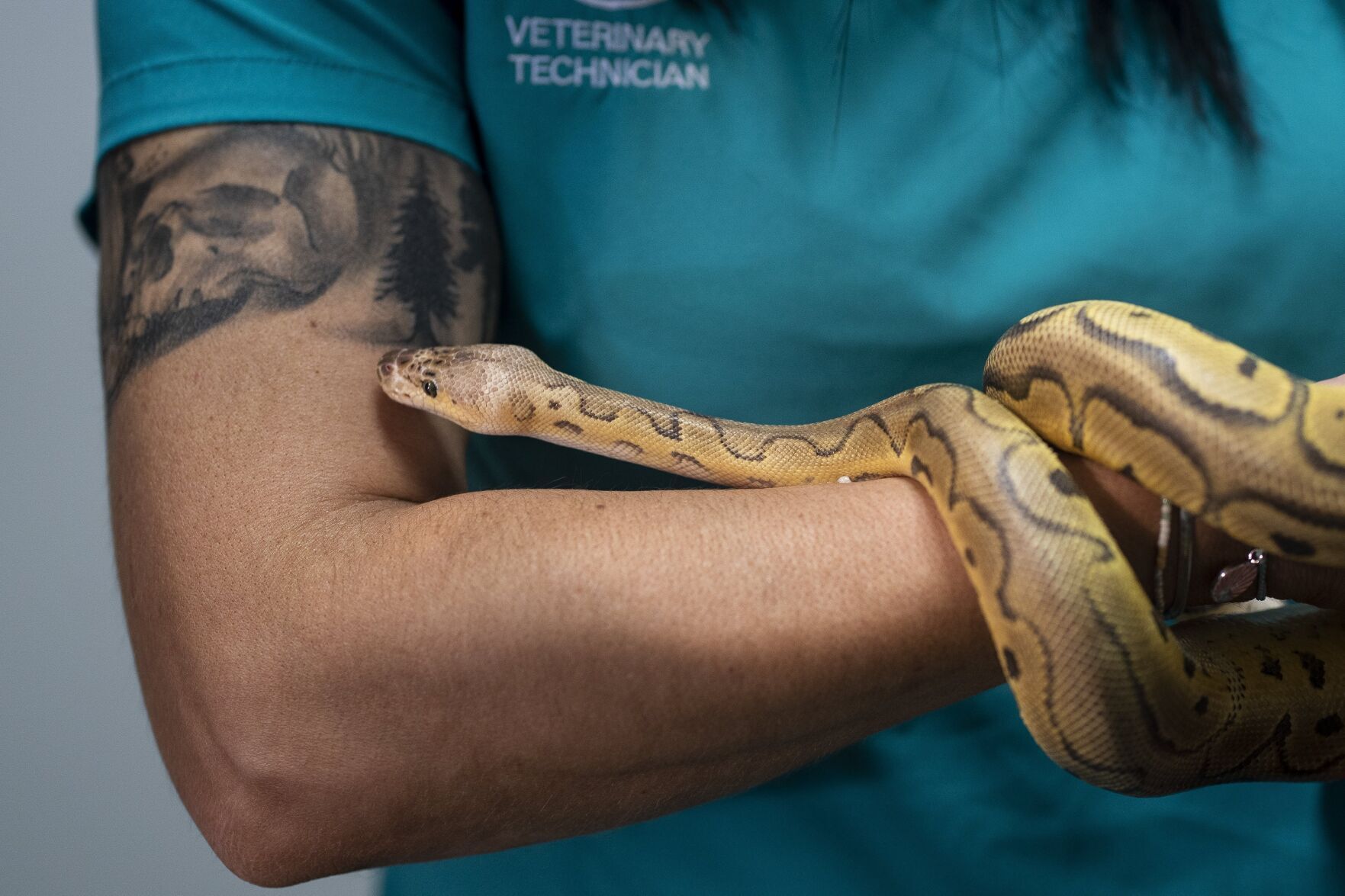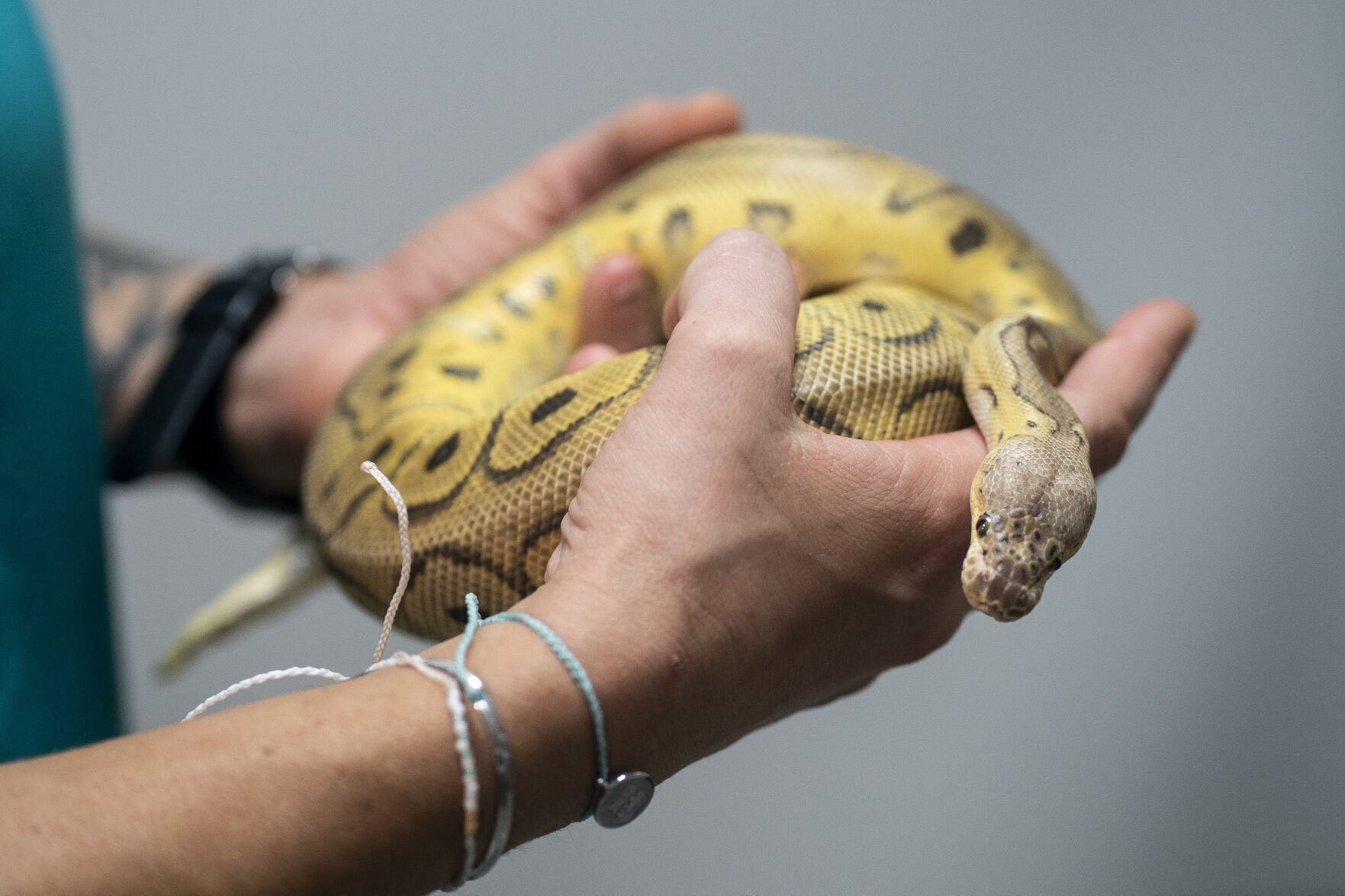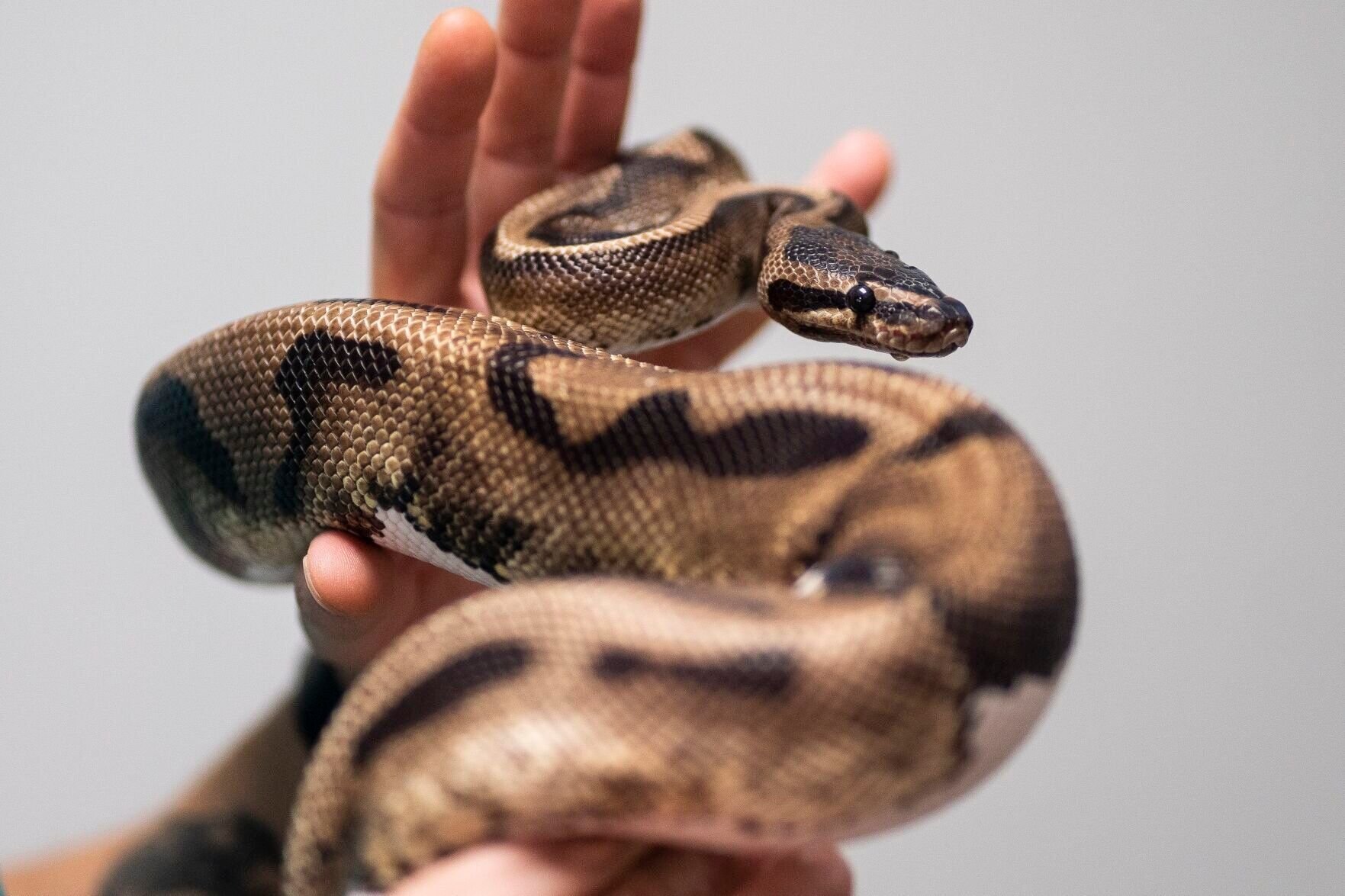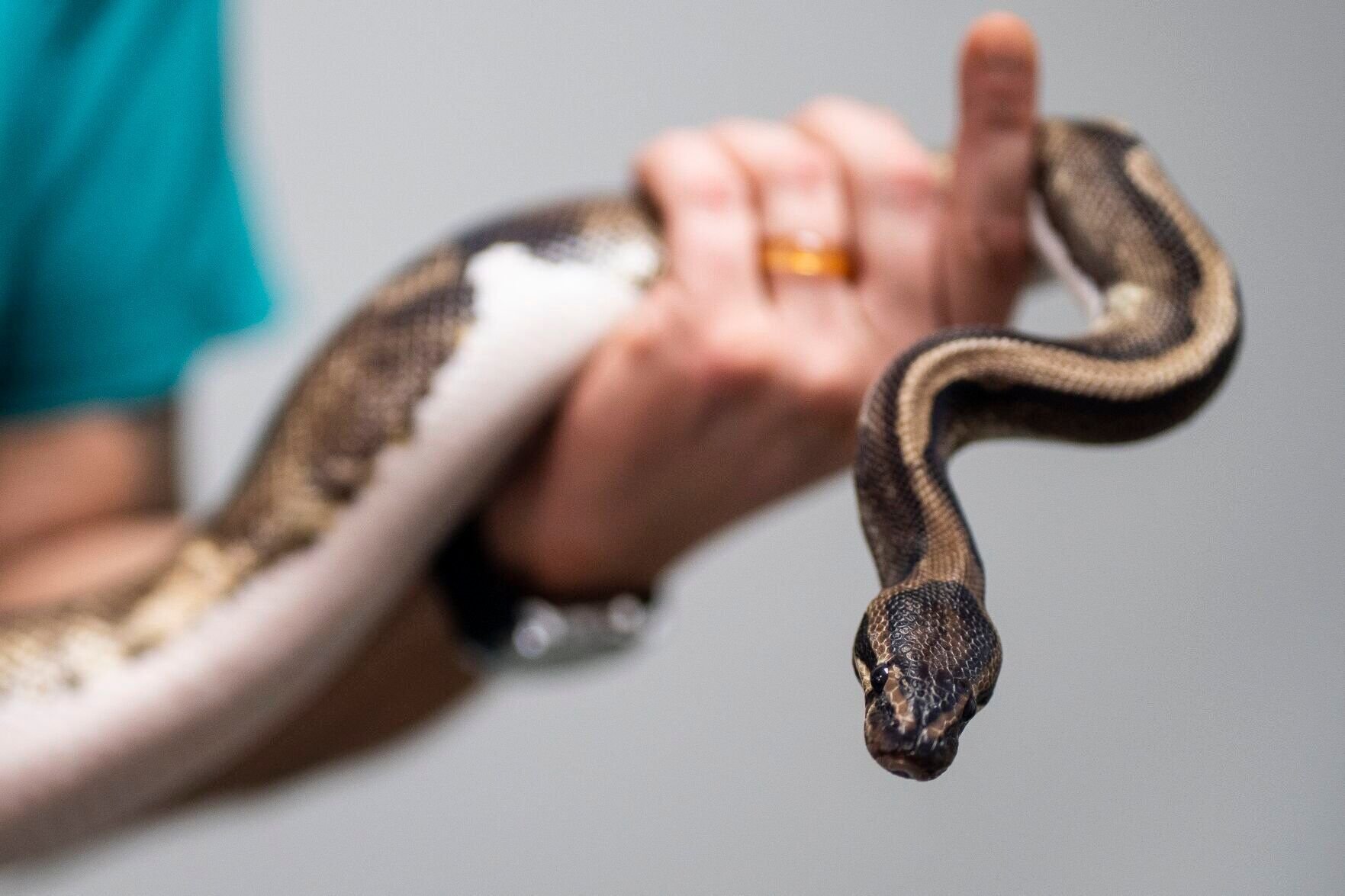BUFFALO, N.Y. — What’s stranger than finding a ball python behind a car wash?
Finding another one in just about the same spot four days later.

Libby March/Buffalo News
Veterinary technician Sara Drumstra displays a ball python found outside a Delta Sonic in Amherst, New York, now safe at SPCA in West Seneca, August 21, 2023. This python was found on Aug. 14, and a second ball python days later on Aug. 18.
The back-to-back serpentine encounters remain a mystery police in the town of Amherst, just north of Buffalo, and to the SPCA Serving Erie County, which publicized them last week.
But the unusual events go back further.
In fact, three other ball pythons – two dead and one living – previously turned up at or near this Delta Sonic car wash, Gina Lattuca, an SPCA spokeswoman, said for the first time Monday.
This makes five pythons in a month.

Libby March, Buffalo News
Veterinary technician Sara Drumstra displays a ball python found outside a Delta Sonic near Buffalo, N.Y.
SPCA officials have developed a number of theories to try to explain this odd chain of events but, so far, say they don’t know exactly why the snakes ended up where they did.
“The situation is probably as unique as the snakes themselves,” said Lattuca, adding she can’t recall this happening before in her 33 years with the agency.
The two most recently discovered ball pythons are staying at the SPCA in West Seneca for now as the agency figures out what to do with them if no one claims them, Lattuca said. Ball pythons are considered good starter pets for would-be snake owners, but they can cost thousands of dollars to purchase.
Amherst police responded to the two latest python sightings at the Delta Sonic.
The first came from a Delta Sonic employee at about 8:10 p.m. on Aug. 14, Amherst Police Capt. Kevin Brown said.
Animal Control Officer Cyndi Griffin and other officers found the snake curled up next to a hose in an outdoor area of the car wash and gas station complex.
Photos posted to the Amherst Police Department’s Facebook page show Griffin holding the snake with one hand and, later, the snake sitting in a cardboard box.
Animal control took the snake to the SPCA in West Seneca the next morning.
An assistant veterinarian gave the ball python – so named because of their tendency to curl into tight balls – a soak in warm water, the SPCA reported on its Facebook page. This encouraged the snake to uncurl – allowing staff to fully examine it – rehydrated the animal and raised its temperature.
“So there you have it – a snake spa adventure like no other at the SPCA!” the agency wrote in its post.

Libby March/Buffalo News
Veterinary technician Sara Drumstra displays a ball python found outside a Delta Sonic near Buffalo, N.Y.
A Delta Sonic worker reported the second snake, found in an outdoor PVC pipe at the business, at 9:10 a.m. Friday, Brown said.
This time, SPCA officers also responded and took the pastel clown ball python back to West Seneca with them.
SPCA officials are not releasing details on the size, age or gender of the snakes, in case an owner comes to claim them.
The first snake that came in has what is known as piebald coloring, with patches of white skin mixed in with its blotchy brown pattern. The second snake is yellow, brown and black throughout.
Ball pythons are non-venomous, average 4 to 5 feet in length and can live for up to 30 years, according to the Petco website. They feed on thawed, frozen rodents.
“The scales on both snakes seem to be in good shape,” Lattuca said. “Neither of them seemed incredibly malnourished.”
That is why the SPCA has concluded the snakes likely were pets.

Libby March/Buffalo News
Veterinary technician Sara Drumstra displays a ball python found outside a Delta Sonic near Buffalo, N.Y.
In the course of digging up some additional information on the latest ball pythons for The Buffalo News, Lattuca learned from an SPCA animal officer about the earlier sightings.
The first, a deceased spider ball python, was found at the car wash sometime in the last week of July, she said.
The second, also deceased, was a piebald python found about a week later on the bike path that runs behind the car wash. The third, another piebald, was also found on the bike path. This snake was alive, Lattuca said, and the person who found it kept it and is trying to find its owner.
Lattuca said one working theory is the snakes’ owner, or owners, tired of caring for them.
But a ball python can cost hundreds or thousands of dollars, so it is not clear why an owner would discard them instead of trying to sell them, she said.
The value depends on whether the snake has the recessive trait, or morph, leading to the partial lack of pigmentation found in piebald pythons that can be passed along in breeding.
Ball pythons are strong enough to escape from an enclosure, Lattuca said, but it is likely that the owner of such valuable snakes would keep them in a secure enclosure.

Libby March/Buffalo News
Veterinary technician Sara Drumstra displays a ball python found outside a Delta Sonic near Buffalo, N.Y.
Amherst police turned the investigation over to the SPCA. Abandoning a pet can lead to an animal cruelty charge in New York, depending on the circumstances, Lattuca said.
The SPCA asks anyone who has information about the snakes to contact its Animal Cruelty Investigations Department at (716) 875-7360, ext. 214.
After taking in a stray, the SPCA holds the animal for five days to see if an owner claims the pet.
Once that period runs out, an animal could be offered for general adoption. But Lattuca said she’s not sure this is a good fit for the snakes because the agency doesn’t want to see someone buy them either to breed them or resell them for a profit.
The SPCA may place them with an established snake owner or even with the Buffalo Zoo, she said.
“These are exceptional animals that require exceptional care,” Lattuca said.
As for Amherst police, would Brown be surprised if his department got a call about another snake at the Delta Sonic?
“In this job, anything can happen,” he said. “So who knows?”
-
Python hunt! 800 compete to remove Florida’s invasive snakes
Natural History Museum of Los An
This rare venomous sea snake found slithering on the sand in Newport Beach is one of a growing number of the serpents apparently drawn far north of their usual habitat by the spread of warm ocean temperatures, a biologist says.
The yellow-bellied sea snake discovered near the 18th Street lifeguard tower on Monday was the third report of the species in Southern California since 2015 — and the fifth since 1972, said Greg Pauly, herpetological curator at the Natural History Museum of Los Angeles County.
"Oceans are warming and the species that respond to that change will be those that are the most mobile," Pauly said. "So the big question now is this: Are sea snakes swimming off the coast of Southern California the new normal?"
Sporting short sharp fangs capable of delivering extremely potent venom, the snake — named for its bright yellow underside and flattened yellow tail with black spots — is no joke.
But Pauly said "these are pretty mellow animals" and they are unlikely to bite a person unless they are picked up.
Natural History Museum of Los An
This rare venomous sea snake found slithering on the sand in Newport Beach is one of a growing number of the serpents apparently drawn far north of their usual habitat by the spread of warm ocean temperatures, a biologist says.
The yellow-bellied sea snake discovered near the 18th Street lifeguard tower on Monday was the third report of the species in Southern California since 2015 — and the fifth since 1972, said Greg Pauly, herpetological curator at the Natural History Museum of Los Angeles County.
"Oceans are warming and the species that respond to that change will be those that are the most mobile," Pauly said. "So the big question now is this: Are sea snakes swimming off the coast of Southern California the new normal?"
Sporting short sharp fangs capable of delivering extremely potent venom, the snake — named for its bright yellow underside and flattened yellow tail with black spots — is no joke.
But Pauly said "these are pretty mellow animals" and they are unlikely to bite a person unless they are picked up.
-
Python hunt! 800 compete to remove Florida’s invasive snakes
David J. Williams/WHO
Saw-scaled, or carpet vipers, are a major cause of snakebite envenoming in Sub-Saharan African savannas north of the rainforest belt, in the Arabian Peninsula and extending through Iran to Pakistan, India and Sri Lanka, according to the World Health Organization. This is a West African carpet viper from Nigeria. (David J. Williams/World Health Organization)
David J. Williams/WHO
Saw-scaled, or carpet vipers, are a major cause of snakebite envenoming in Sub-Saharan African savannas north of the rainforest belt, in the Arabian Peninsula and extending through Iran to Pakistan, India and Sri Lanka, according to the World Health Organization. This is a West African carpet viper from Nigeria. (David J. Williams/World Health Organization)
-
-
Python hunt! 800 compete to remove Florida’s invasive snakes
David J. Williams/WHO
Several cobra species belong to the genus Naja, according to the World Health Organization. Cobras are found throughout Sub-Saharan Africa, the Arabian Peninsula, parts of the Middle East and Central Asia, as well as throughout South and South East Asia. This is an Egyptian cobra, photographed in Kenya. (David J. Williams/World Health Organization)
David J. Williams/WHO
Several cobra species belong to the genus Naja, according to the World Health Organization. Cobras are found throughout Sub-Saharan Africa, the Arabian Peninsula, parts of the Middle East and Central Asia, as well as throughout South and South East Asia. This is an Egyptian cobra, photographed in Kenya. (David J. Williams/World Health Organization)
-
Python hunt! 800 compete to remove Florida’s invasive snakes
David J. Williams/WHO
Several cobra species belong to the genus Naja, according to the World Health Organization. Cobras are found throughout Sub-Saharan Africa, the Arabian Peninsula, parts of the Middle East and Central Asia, as well as throughout South and South East Asia. This is a monocellate cobra from Thailand. (David J. Williams/World Health Organization)
David J. Williams/WHO
Several cobra species belong to the genus Naja, according to the World Health Organization. Cobras are found throughout Sub-Saharan Africa, the Arabian Peninsula, parts of the Middle East and Central Asia, as well as throughout South and South East Asia. This is a monocellate cobra from Thailand. (David J. Williams/World Health Organization)
-
-
Python hunt! 800 compete to remove Florida’s invasive snakes
David J. Williams/WHO
Puff adders are found in Sub-Saharab Africa and the Arabian Peninsula, causing many snakebites that result in permanent disability or death, according to the World Health Organization. This puff adder is from Kenya. (David J. Williams/World Health Organization)
David J. Williams/WHO
Puff adders are found in Sub-Saharab Africa and the Arabian Peninsula, causing many snakebites that result in permanent disability or death, according to the World Health Organization. This puff adder is from Kenya. (David J. Williams/World Health Organization)
-
Python hunt! 800 compete to remove Florida’s invasive snakes
David J. Williams/WHO
Mambas are a group of widely distributed venomous snakes with neurotoxic venom, feared because of high fatality rates associated with envenoming, according to the World Health Organization. This is a black mamba photographed in Swaziland. (David J. Williams/World Health Organization)
David J. Williams/WHO
Mambas are a group of widely distributed venomous snakes with neurotoxic venom, feared because of high fatality rates associated with envenoming, according to the World Health Organization. This is a black mamba photographed in Swaziland. (David J. Williams/World Health Organization)
-
-
Python hunt! 800 compete to remove Florida’s invasive snakes
David J. Williams/WHO
Russell's vipers are responsible for thousands of snakebite envenoming cases in South and South East Asia, according to the World Health Organization. Bites by this snake are a major cause of acute kidney injury requiring haemodialysis. This is a Siamese Russell's viper from Cambodia. (David J. Williams/World Health Organization)
David J. Williams/WHO
Russell's vipers are responsible for thousands of snakebite envenoming cases in South and South East Asia, according to the World Health Organization. Bites by this snake are a major cause of acute kidney injury requiring haemodialysis. This is a Siamese Russell's viper from Cambodia. (David J. Williams/World Health Organization)
-
Python hunt! 800 compete to remove Florida’s invasive snakes
David J. Williams/WHO
Several krait species with potent neurotoxic venom are found in South and South East Asia, according to the World Health Organization. They can enter homes at night, biting people sleeping on floor mats. This is the Malayan krait from Thailand. (David J. Williams/World Health Organization)
David J. Williams/WHO
Several krait species with potent neurotoxic venom are found in South and South East Asia, according to the World Health Organization. They can enter homes at night, biting people sleeping on floor mats. This is the Malayan krait from Thailand. (David J. Williams/World Health Organization)
-
-
Python hunt! 800 compete to remove Florida’s invasive snakes
David J. Williams/WHO
The Malayan pit viper is a major cause of snakebite envenoming in South East Asia, according to the World Health Organization. They are found in forests and plantations, remaining motionless. Many victims are bitten after walking on or near it. This is a Malayan pit viper from Cambodia. (David J. Williams/World Health Organization)
David J. Williams/WHO
The Malayan pit viper is a major cause of snakebite envenoming in South East Asia, according to the World Health Organization. They are found in forests and plantations, remaining motionless. Many victims are bitten after walking on or near it. This is a Malayan pit viper from Cambodia. (David J. Williams/World Health Organization)
-
Python hunt! 800 compete to remove Florida’s invasive snakes
David J. Williams/WHO
Papuan taipans cause the most deaths from snakebite in Australia and Papua New Guinea, according to the World Health Organization, with most occurring in Papua New Guinea. Fatality rates are close to 100 percent without antivenom. (David J. Williams/World Health Organization)
David J. Williams/WHO
Papuan taipans cause the most deaths from snakebite in Australia and Papua New Guinea, according to the World Health Organization, with most occurring in Papua New Guinea. Fatality rates are close to 100 percent without antivenom. (David J. Williams/World Health Organization)
-
-
Python hunt! 800 compete to remove Florida’s invasive snakes
David J. Williams/WHO
According to the World Health Organization, brown snakes from genus Pseudonaja cause 50 percent of all snakebite-related deaths in Australia. This is a common brown snake from eastern Australia. (David J. Williams/World Health Organization)
David J. Williams/WHO
According to the World Health Organization, brown snakes from genus Pseudonaja cause 50 percent of all snakebite-related deaths in Australia. This is a common brown snake from eastern Australia. (David J. Williams/World Health Organization)
-
Python hunt! 800 compete to remove Florida’s invasive snakes
David J. Williams/WHO
Several lancehead viper species are found throughout Central and South America, according to the World Health Organization. They are responsible for many snakebite envenomings. This is a Bothrops asper from Costa Rica. (David J. Williams/World Health Organization)
David J. Williams/WHO
Several lancehead viper species are found throughout Central and South America, according to the World Health Organization. They are responsible for many snakebite envenomings. This is a Bothrops asper from Costa Rica. (David J. Williams/World Health Organization)
-
-
Python hunt! 800 compete to remove Florida’s invasive snakes
David J. Williams/WHO
Rattlesnakes are found from southern Canada, throughout the United States and into Mexico, as well as Central and the northern half of South America, according to the World Health Organization. Bites are common. This is a neotropical rattlesnake from South America. (David J. Williams/World Health Organization)
David J. Williams/WHO
Rattlesnakes are found from southern Canada, throughout the United States and into Mexico, as well as Central and the northern half of South America, according to the World Health Organization. Bites are common. This is a neotropical rattlesnake from South America. (David J. Williams/World Health Organization)





